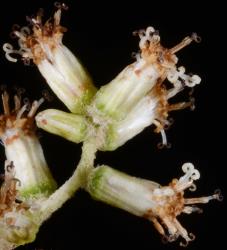- Taxon
- Gallery
- ≡ Cineraria repanda (J.R.Forst. & G.Forst.) G.Forst., Fl. Ins. Austr. 56 (1786)
- = Senecio georgii Endl. (1836)
- = Senecio forsteri Hook.f., Bot. Antarct. Voy. II. (Fl. Nov.-Zel.) Part I, 148 (1853) – as Senecio (Brachyglottis) forsteri
- = Brachyglottis repanda var. rangiora (Buchanan) Allan, Fl. New Zealand 1, 757 (1961)
Shrub or tree up to 6 m. or more tall, with stout brittle spreading branches densely clad in soft white to buff subappressed tomentum. Lvs membr. to subcoriac.; lamina 5–25 × 5–20 cm., broad- to ovate-oblong in outline, obtuse to subacute, obliquely cordate to truncate at base, margins distantly dentately lobed to sinuate; petiole stout, grooved, up to 10 cm. long. Panicles large, much-branched; capitula c. 5 mm. diam., ∞; phyll. c. 3 mm. long, narrow-oblong to narrow-spathulate, scarious except at very base, pale except at midvein. Florets 10–12; achenes < 1 mm. long, hispid-papillose; pappus-hairs up to 3 mm. long, minutely barbellate.
[From: Allan (1961) Flora of New Zealand. Volume 1.]
| Category | Number |
|---|---|
| Indigenous (Endemic) | 2 |
| Total | 2 |
Flowering: Aug.–Oct.; Fruiting: Nov.–Feb.




